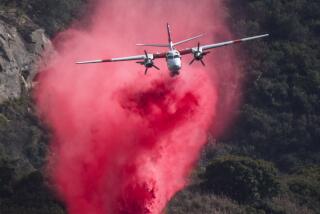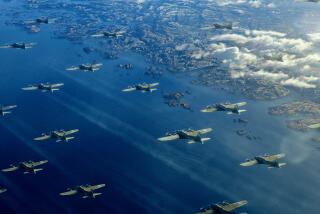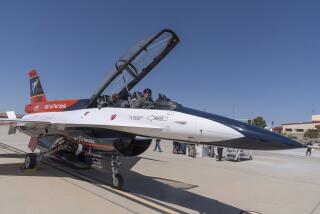Charting the Flight of Fall Guys
- Share via
CALIFORNIA CITY — In a few minutes, Dennis LaChaine was going to take his first ride on an airplane. Then, at 3,000 feet, he would take his first ride outside an airplane. You’d think he’d be nervous.
“No problem,” he said. “I’m totally relaxed.”
Wearing a dashing red jump suit and a day’s stubble, LaChaine was psyched for an adventure in parachuting. He and buddies Greg Jones and Doug Loper, all in their early 20s, had taken Bill Reed’s three-hour class, Parachuting 101, and were graduating two days later in the empty blue skies near Edwards Air Force Base.
“We’re not daredevils,” LaChaine said. “But Bill’s class made parachuting seem safer than we thought.”
But even though they would be on a static line, even though they would be jumping with two chutes, they wouldn’t allow themselves to be convinced that parachuting wasn’t just a tad dangerous. “You only live once,” Jones said, laughing. The others laughed with him, shaking their fists at fate.
Earlier that Saturday morning, they had driven nearly three hours from Ventura to a small airport in this small, barren desert community that bills itself as “the land of the sun.” Along with dozens of other young people, they paid $149 apiece for the opportunity to jump from an airplane onto the Mojave Desert.
After an hour of lessons on a jump simulator, they were issued equipment by the California City Parachute Club. Gear included a main parachute and a backup, a radio receiver, jump suit and helmet. Inside a large sheet-metal clubhouse, instructors were busy repacking chutes to satisfy a continuous parade of jumpers. Adding to the buzz was a squawking parrot named Dudley.
When it was time to take off, Bill Reed, wearing a polo shirt beneath his harness and a battered brown helmet on his head, took the three jumpers to a parked Cessna 206 on the runway. Attached to the wing strut across from the cargo door was a Minolta camera, which snaps a jumper’s photo at the moment of his exit from the plane.
“Think parachuting,” Reed said as he packed the jumpers backwards into the cargo hold.
The single-engine plane took off for the drop zone, about a quarter-mile away. While it circled for altitude, Bob Sinclair drove the recovery truck to the target area, a circle 500 feet in diameter, scratched into the desert. Sinclair, a bearded ex-paratrooper who says he trained Johnny Carson to jump, was acting as ground controller for Reed.
The yellow Cessna approached from the northeast. Inside the plane, Jones was being prepped to jump. Reed, the jump master, checked his equipment and went over the procedure for the first five seconds of the jump. Then Jones draped his feet over the side and pushed off.
Looking up, Sinclair saw an object the size of a postage stamp. The main chute had opened at 2,500 feet, stopping Jones’ plunge. But now he was gliding away from the target area. Sinclair stood beside the truck and held the radio mike to his mouth.
“I need a 180-degree right turn,” he said to Jones. “Good, Greg. Keep turning till I tell you to stop. That’s it. Keep facing that way. Now give me a 90-degree right turn.”
By now the plane had circled back and disgorged LaChaine. Sinclair turned his attention to him. “You got a good parachute, Dennis. Take the brakes off and do a 180.”
Jones, meanwhile, was sailing away from the target. “Greg, right turn now!” Sinclair barked into the mike. “You’re wandering around on your own up there.” Jones maneuvered into position to land but came down too fast. “Flare!” Sinclair ordered. Jones slowed his descent but not enough to prevent him from tumbling when he hit the ground.
Sinclair shook his head and then looked up again into the sky. Loper had made his exit and was floating toward Las Vegas. “Doug, where you going?” Sinclair asked him over the radio. “Face the drop zone.”
As Loper made adjustments, LaChaine was about to land. At the precise time, he pulled down on the brakes to flare the chute and dropped softly on both feet. “That’s a keeper,” Sinclair said.
Loper, however, was not so lucky. Sinclair talked him over the target area, but the final few feet were the hardest. Loper seemed to make a one-point landing on his seat, kicking up a minor dust storm as the chute dragged him a few feet.
Sinclair scoffed. “He looked like an Irish washerwoman on the way down.” Then Sinclair got in the truck and went to retrieve the fallen adventurers.
“I was preoccupied up there,” Loper said. “My mind was racing. I had a hard time hearing the radio.”
LaChaine, of course, was crowing. “It was a piece a cake,” he said. Anything unexpected come up? He thought for a second and said, “The egg burrito almost did.”
More to Read
Sign up for The Wild
We’ll help you find the best places to hike, bike and run, as well as the perfect silent spots for meditation and yoga.
You may occasionally receive promotional content from the Los Angeles Times.






